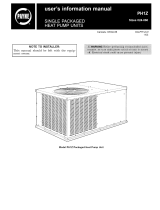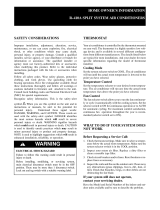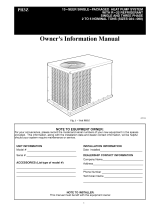Page is loading ...

NOTE TO INSTALLER:
This manual should be left with the equipment
owner.
WARNING:Before performing recommended main-
tenance, be sure main power switch to unit is turned
off. Electrical shock could cause personal injury.
Model 664A PackagedHeatPump
user’s information manual
SINGLEPACKAGED
HEAT PUMP UNITS
664A
Sizes024-060
Cancels:OM02-55 OM02-64
1/03

WELCOME TO EFFICIENT
YEAR-ROUND COMFORT
Congratulations on your excellent choice and sound invest-
ment in home comfort! Your new heat pump represents both
the latest in engineering development and the culmination
of many years of experience from one of the most reputable
manufacturers of comfort systems. Your new unit is among
the most reliable home comfort products available today. To
assure its dependability, spend just a few minutes with this
booklet now. Learn about the operation of your heat pump
and the small amount of maintenance it takes to keep it op-
erating at its peak efficiency.
With minimal care, your heat pump will provide you and your
family with dependable home comfort — both now and for
years to come.
IMPORTANT FACTS
To better protect your investment and to eliminate unneces-
sary service calls, familiarize yourself with the following facts:
WARNING:
Improper installation, adjustment, alter-
ation, service, maintenance, or use can cause explo-
sion, fire, electrical shock, or other conditions whichmay
cause personal injury or property damage. Refer to this
manual. For assistance or additional information con-
sult a qualified installer, service agency, distributor, or
branch office. The qualified installer or agency must use
only factory authorized kits or accessories when modi-
fying this product.
• Your heat pump system should never be operated without
a clean air filter properly installed. Plan to inspect the filter
periodically. A clogged air filter will increase operating costs
and shorten the life of the unit.
• Supply-air and return-air registers should not be blocked.
Drapes, furniture, and toys are some of the items commonly
found obstructing grilles. Restricted airflow lessens the unit’s
efficiency and life span.
• Outdoor units must have unrestricted airflow. Do not cover
the unit, lean anything against it, or stand upon it. Do not
allow grass clippings, leaves, or other debris to accumulate
around or on top of the unit. Maintain a 12-inch minimum
clearance between the outdoor unit and tall grass, vines, shrubs,
et cetera.
• Your multipurpose indoor thermostat is the control center
for your heat pump system. You should familiarize yourself
with its proper operation. Attempting to control the system
by other means — for instance, switching the electrical sup-
ply power ON and OFF — may cause damage to the unit.
• Thermostat ‘‘jiggling’’causes rapid-cycling, which is poten-
tially damaging to the compressor. Do not move the tempera-
ture selector on the thermostat for any reason for at least
5 minutes after the compressor has shut off.
• You may find that you can maintain greater personal com-
fort by running the fan continuously. ‘‘Air pockets’’ can form
due to the structure of the building, placement of registers,
et cetera. These air pockets may be too cool or warm for your
liking. Continuous fan operation minimizes any temperature
differences. Also, systems equipped with electronic air clean-
ers and/or humidifiers offer the added benefits of having the
air continuously cleaned year-round, and humidified during
the winter season.
• Your heat pump will remove humidity from your home dur-
ing the cooling season. After a few minutes of operation, you
should be able to see water trickle from the condensate drain.
Check this occasionally to be sure the drain system is not
clogged. Of course, do not expect to see much drainage if you
live in a very dry climate.
OPERATING YOUR HEAT PUMP
The operation of your heat pump system is controlled by the
indoor thermostat. You simply adjust the thermostat and it
maintains the indoor temperature at the level you select. Most
thermostats for heat pump systems include temperature con-
trol selector, FAN switch, and SYSTEM switch. EMER-
GENCY HEAT control is usually provided with the SYSTEM
switch.
Thetemperaturecontrolselectorisadialor button(s) thatal-
lows you to establish the temperature that you wish to main-
tain for your personal comfort. Some thermostats possess two
temperature control selectors: one for setting the tempera-
ture desired during the cooling cycle, and one to set the heat-
ing operation temperature. Typical settings are 78 degrees
Fahrenheit for cooling and 68 degrees for heating.
The FAN switch offers two options for controlling the blower:
AUTO and ON. When set to AUTO, the blower will run dur-
ing the time the heat pump is operating. When the FAN switch
is set at the ON position, the blower will run continuously.
Typically, the SYSTEM switch on your thermostat offers the
following selections: COOL, OFF, and HEAT. Your thermo-
stat may also have a another selection,AUTO. The heat pump
will not operate when the SYSTEM switch is set at the OFF
position. With the SYSTEM switch set at COOL, your heat
pump will operate in its cooling mode when the indoor tem-
perature rises above the level that you wish to maintain. With
the SYSTEM switch set at the HEAT position, your heat pump
will provide warmth whenever the indoor temperature falls
below the level that you have selected.
The AUTO selection found on some thermostats provides for
automatic changeover between cooling and heating cycles. With
the SYSTEM switch set in the AUTO position, the cooling
mode is activated when the indoor temperature rises above
the thermostat cooling temperature setting, or the heating
mode will be activated when the indoor temperature drops
below the thermostat setting for the heating cycle.
Depending on your typical winter heating needs, your home
comfort system may include a supplementary heating source.
The EMERGENCY HEAT switch provides for convenient se-
lection between two heating modes. Your heat pump will op-
erate when the switch is set at NORMAL. With the switch
set at the EMERGENCY HEAT position, the heat pump will
turn off and the supplementary heat source will be activated.
COOLING CYCLE
When operating in the cooling cycle, your heat pump will run
until the indoor temperature is lowered to the level you have
selected. On extremely hot days, your heat pump will run for
longer periods at a time and have shorter ‘‘off’’ periods than
on moderate days.
—2—

The following are typical conditions that add extra heat and/or
humidity to your home. Your heat pump will work longer to
keep your home comfortable under these conditions:
• Entrance doors are frequently opened and closed
• Laundry appliances are being operated
• A shower is running
• More than the usual number of people are present in the
home
• More than the normal number of electric lights are in use
• Drapes are open on the sunny side of the home
HEATING CYCLE
With the SYSTEM switch of your indoor thermostat set to
the HEAT position, the heat pump will operate in its heating
mode until room temperature is raised to the level you have
selected. Of course, the heating unit will have to operate for
longer periods to maintain a comfortable environment on colder
days and nights than on moderate ones.
Defrost Cycle — When your heat pump is providing heat to
your home and the outdoor temperature drops below 45 de-
grees Fahrenheit, moisture may begin to freeze on the sur-
face of the outdoor coil. If allowed to build up, this ice would
impede airflow across the coil and reduce the amount of heat
absorbed from the outside air. So, to maintain energy-
efficient operation, your heat pump has an automatic defrost
cycle.
The defrost cycle starts at a preset time interval of 30 min-
utes. Defrost will start at the preset time only if the ice is
sufficient to interfere with normal heating operation.
After the ice is melted from the outdoor coil, or after a maxi-
mum of 10 minutes in the Defrost mode, the unit will auto-
matically switch back to normal heating operation.
Do not be alarmed if steam or fog appears at the outdoor unit
during the defrost cycle. Water vapor from the melting ice
may condense into a mist in the cold outside air.
Emergency Heat — The EMERGENCY HEAT setting on your
thermostat refers to any supplementary heating appliance that
may be included in your home comfort system. Operation of
the EMERGENCY HEAT source may be required if heating
demands exceed the capacity of the heat pump, or if the heat
pump malfunctions.
The word Emergency will display onyourthermostat if the
mode button is selected for theEMERGENCYHEAT mode
setting. This indicates that the heat pump is off and the supple-
mental heating appliance is selected for operation.
The word AUXHEATwill be displayed undernormaloperation
when the second stage of heat is operating.
During the heating season, switch to EMERGENCY HEAT if
the electricity to your outdoor unit is off for more than
30 minutes for any reason (i.e., power outage). Leave the switch
in the EMERGENCY HEAT position for an amount of time
equal to that during which the power was off. It is not nec-
essary to exceed 12 hours. If you cannot determine how long
the power has been off, leave the switch in the EMER-
GENCY HEAT position for 8 hours.
PERFORMING ROUTINE MAINTENANCE
With the proper maintenance and care, your heat pump will
operate economically and dependably. Maintenance can be ac-
complished easily by referring to the following directions. How-
ever, before performing maintenance, consider these impor-
tant safety precautions:
• DISCONNECTALL ELECTRICAL POWER TO THE HEAT
PUMP BEFORE REMOVING ACCESS PANELS TO PER-
FORM SERVICE OR MAINTENANCE. NOTE: THERE MAY
BE MORE THAN ONE ELECTRICAL DISCONNECT
SWITCH.
• ALTHOUGH SPECIAL CARE HAS BEEN TAKEN TO
MINIMIZE SHARP EDGES IN THE CONSTRUCTION OF
YOUR UNIT, BE EXTREMELY CAREFUL WHEN HAN-
DLING PARTS OR REACHING INTO THE UNIT.
CHECK THE AIR FILTER
A dirty air filter will cause excessive strain on the compres-
sor and blower motor. This can cause the components to over-
heat and automatically shut down. In the extreme, the com-
ponents will fail and need to be replaced. To avoid inefficient
or failed operation of your unit, CHECK THE FILTER(S) EV-
ERY 3 TO 4 WEEKS. Replace filter(s) when necessary, or clean
the filter(s) if you have the reusable type.
Disposable filters should be replaced by similar, new filters
of the same dimensions.
—3—
• Do not operate your unit in the heating mode when outdoor
temperatures are above 66°F unless you set your thermostat
to emergency heat mode.

Reusable, permanent filters should be washed in a solution
of cold water and mild detergent, then rinsed and thoroughly
dried. THE FILTER MUST BE COMPLETELY DRY BE-
FORE BEING REINSTALLED. To avoid prolonged shut-
down of your unit while a filter is drying, you should have an
extra filter on hand. This would allow you to rotate between
the two with minimal downtime for your comfort system. Ex-
tra filters may be purchased from your dealer.
• The filter(s) and filter rack for a packaged system are sup-
plied and installed by the contractor or dealer. Typically, the
filter(s) and rack are located in the return-air duct in the unit
or behind the return-air grille(s). Have your dealer show you
the location of your filter(s) and the procedures for removal
and replacement.
If you have any questions about the removal and/or cleaning
of your filter(s), contact your dealer for assistance.
If grass clippings, leaves, shrubbery, and debris are kept away
from the unit, minimal care should be sufficient to keep the
system functioning properly. However, if the outdoor coil be-
comes dirty, use a brush or vacuum cleaner and soft brush
attachment to clean the exterior surface. If dirt is deep in the
coil, contact your dealer for service. The outdoor-fan motor
may have to be disconnected and the top panel removed to
gain access to the coil for thorough cleaning. Do not attempt
this yourself.
UNIT SUPPORT
Your packaged unit should be maintained at a level position.
If its support should shift or settle so that the unit is no longer
level, you should correct the condition. Relevel it promptly to
assure condensate drainage out of the unit. If you notice that
water or ice collects beneath the unit, arrange for it to be drained
away from the unit.
BEFORE YOU REQUEST A SERVICE CALL
BEFOREYOUCALLFORSERVICE,CHECKFORTHESE
EASILYSOLVEDPROBLEMS:
• Check the disconnect switches. Verify that circuit break-
ers are ON or that fuses have not blown.
• Check for sufficient airflow. Check the air filter(s) for any
accumulations of dirt. Check for blocked return-air or supply-
air grilles. Be sure grilles are open and unobstructed.
• Check the settings on your indoor thermostat. If you de-
sire cooling, see that the temperature control selector is set
below room temperature and the SYSTEM switch is on the
COOL or AUTO position. If you require warmth, be sure the
temperature control selector is set above room temperature
and the SYSTEM switch is at HEAT orAUTO. The FAN switch
should be set at ON for continuous blower operation or AUTO
if you wish the blower to function only while the unit is
operating.
If your comfort system still fails to operate, contact your ser-
vicing dealer for troubleshooting and repairs. Specify your ap-
parent problem, and state the model and serial numbers of
your equipment. (You should have them recorded at right.)
With this information, your dealer may be able to offer help-
ful suggestions over the phone, or save valuable time through
knowledgeable preparation for the service call.
REGULAR DEALER MAINTENANCE
In addition to the routine maintenance that you perform, your
home comfort system should be inspected regularly by a prop-
erly trained service technician. The inspection (preferably
each year, but at least every other year) should include the
following:
• Routine inspection of air filter(s). Replacement or cleaning
as required.
• Inspection and cleaning of the blower wheel, housing,
and motor. Service should include proper lubrication of these
components.
• Inspection and, if required, cleaning of indoor and outdoor
coils.
• Inspection of the indoor coil drain pan, plus the drain line.
Service should include cleaning if required.
• A check of all electrical wiring and connections.
• A check for secure physical connections of individual com-
ponents within units.
• Operational check of the heat pump system to determine
actual working condition. Necessary repair and/or adjust-
ment should be performed at this time.
Your servicing dealer may offer an economical service con-
tract that covers seasonal inspections. Ask for further
details.
WARRANTIES
Awarranty is located at the back of this book. Be sure to read
the warranty carefully to determine the coverage for your unit.
FOR THE RECORD
Record the model, product, and serial numbers of your new
equipment in the spaces provided below. This information,
along with the other ready-reference facts requested below,
will be necessary should you ever require information or
service.
Installation Data
Date Installed
Dealer Name
Address
City
State Zip
Telephone
Packaged System
Outdoor Unit:
Product No.
Model No.
Serial No.
Heater, if applicable:
Part No.
Kilowatt Rating
—4——4——4—
Copyright2003 Bryant Air Conditioning Company CATALOGNO.5366-403
/


